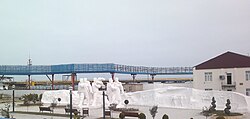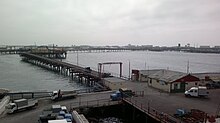Neft Daşları
Neft Daşları | |
|---|---|
 Oil Rocks monuments | |
| Coordinates: 40°14′10″N 50°51′30″E / 40.23611°N 50.85833°E | |
| Country | Azerbaijan |
| City | Baku |
| District | Pirallahi |
| Municipality | Çilov-Neft Daşları |
| Population (2008)[1] | |
| • Total | 2,000 |
| Time zone | UTC+4 (AZT) |
Neft Daşları (pronounced [ˈneft dɑʃlɑˈɾɯ] lit. 'Oil Rocks') is an industrial settlement in Baku, Azerbaijan. The settlement forms part of the municipality of Çilov-Neft Daşları in the Pirallahy raion.[2] It lies 100 km (62 mi) away from the Azerbaijani capital Baku, and 55 km (34 mi) from the nearest shore in the Caspian Sea. A full town on the sea, it was the first oil platform in Azerbaijan, and the first operating offshore oil platform in the world, incorporating numerous drilling platforms. It is featured in Guinness World Records as the world's first offshore oil platform.[3]
The settlement began with a single path out over the water and grew into a system of paths and platforms built on the back of ships sunk to serve as the Neft Daşları's foundation.[4] The most distinctive feature of Neft Daşları is that it is actually a functional city with a population of about 2,000 and over 300 km (190 mi) of streets built on piles of dirt and landfill.[5]

Etymology
[edit]The settlement was originally named as Chernie Kamni ("Black Stones"), but was later renamed to Neft Daşları ("Oily Rocks"), replacing the allusion to the black colour of oil with a reference to the substance itself.[6][7]
History
[edit]Construction of the settlement
[edit]
The first large-scale geological study of the area was conducted in 1945–1948.[8] The settlement of Neft Daşları was built after oil was discovered there on 7 November 1949,[9] at 1,100 metres (3,600 ft) beneath the Caspian Sea and it became the world's first offshore oil platform.[10][11]
By 1951, the Neft Daşları was ready for production, equipped with all of the infrastructure needed at the time. Drilling platforms were erected, oil tanks installed, and docks with enclosures for ships were built. The first oil from the Neft Daşları was loaded into a tanker in the same year.[12]
In 1952, the systematic construction of trestle bridges connecting the artificial islands was begun. A number of Soviet factories constructed crane assemblies especially for use on the Neft Daşları, along with a crane barge that could carry up to 100 tons of oil. The assemblies were equipped with diesel hammers used to drive piles into the sea floor.[12]
Large-scale construction started on the settlement in 1958, which included nine-story hostels, hotels, cultural palaces, bakery factories and lemonade workshops.[8] The mass development of Neft Daşları continued during 1976–1978 with the building of a five-story dormitory and two oil-gas compressor stations, the installation of a drinking water facility, and the construction of two underwater pipelines to the Dubendi terminal, each with a diameter of 350 millimetres (14 in).[8] In addition, a flyover for vehicular traffic was created.[8] As a result, the area of the settlement grew to around 7 hectares (17 acres) in the 1960s, with the length of the steel trestle bridges joining the man-made islands exceeding 200 kilometres (120 mi).[12]
Post-independence
[edit]In November 2009, the settlement celebrated its 60th anniversary.[13][14] Over the last 60 years, the oilfields of Neft Daşları have produced more than 170 million tons of oil and 15 billion cubic metres of associated natural gas.[12] According to present-day estimates by geologists, the volume of recoverable reserves is as high as 30 million tons.[12] The oil platforms have gradually fallen into disrepair, and no refurbishment plans are currently underway.[9]
Demography
[edit]The population varies from time to time in the settlement. As of 2008, the platforms have a combined population of about 2,000 men and women, who work in week-long offshore shifts. At one point[when?] 5,000 people worked there.[15]
Oil extraction
[edit]The oil extraction is carried out from the shallow water portion of the Absheron geological trend.[citation needed]
Accidents
[edit]On 4 December 2015, three workers of SOCAR were reported missing after part of the living quarters fell into the sea due to a heavy storm.[16]
In popular culture
[edit]- In 2008, a Swiss documentary crew led by film director Marc Wolfensberger filmed "La Cité du Pétrole / Oil Rocks – City above the Sea" in the settlement, which was released in 2009.[17] Vimeo
- Neft Daşları is featured in a scene in the James Bond film The World Is Not Enough (1999).[18][19]
- Neft Daşları is on the list in the Guinness Book as the oldest offshore oil platform.[3]
References
[edit]- ^ World Gazetteer: Azerbaijan[dead link] – World-Gazetteer.com
- ^ "Neft Daşları adası" (in Azerbaijani). PİRALLAHI RAYON Icra Hakimiyyəti. Retrieved 23 November 2019.
- ^ a b "Oldest offshore oil platform". Guinness World Records. Retrieved 29 July 2016.
- ^ Gale, Timothy. "OIL ROCKS: AN INFRASTRUCTURED SOVIET CITY". Archived from the original on 2 April 2014. Retrieved 26 December 2010.
- ^ Theroux, Marcel. "The Rock of Ages". Retrieved 26 December 2010.
- ^ Abbasov, Mehti. "НЕФТЯНЫЕ КАМНИ — 60". Bakinskiy Rabochiy Newspaper. Retrieved 26 December 2010.
- ^ Ibrahimov, Seyyad. "THE EARLY DAYS". Azerbaijan International Magazine. Retrieved 26 December 2010.
- ^ a b c d "Baku and Oil. The Soviet Period". window2baku.com. Retrieved 25 December 2010.
- ^ a b Frank, Arno. "The Rise and Fall of Stalin's Atlantis". Der Spiegel. Retrieved 11 February 2018.
- ^ "Oil platforms". Retrieved 25 December 2010.
- ^ Blair, Betty. "Oil Rocks in the Caspian". azer.com. Retrieved 25 December 2010.
- ^ a b c d e Igorev, Vladimir. "A MAN-MADE ISLAND OF OIL TREASURES". www.oilru.com. Retrieved 25 December 2010.
- ^ "Городу в Каспийском море уже 60 лет". Lifenews.ru. Retrieved 25 December 2010.
- ^ "Oil Rocks is essential value for Azerbaijani people: president – update". today.az. Retrieved 25 December 2010.
- ^ Frank, Arno (14 November 2012). "Forbidden City of Oil Platforms: The Rise and Fall of Stalin's Atlantis". Der Spiegel. Retrieved 27 February 2014.
- ^ "Oil workers 'missing' at Socar platform". Upstream Online. NHST Media Group. 4 December 2015. Retrieved 5 December 2015.
- ^ "Oil Rocks: City Above the Sea". IMDb.
- ^ Turnbull, James. "Oil Rocks". Retrieved 26 December 2010.
- ^ Patterson, Jean. "Agent 007 Movie Scenes Shot in Baku". Azerbaijan International Magazine. Retrieved 26 December 2010.
External links
[edit]- Map of the area
- Photos of Oil Rocks taken in 2013
- Travel guide for Oil Rocks
- English Russia: Oil Stones, A Soviet City in the Middle of the Sea
- Link to the film trailer Oil Rocks – City above the Sea
- Neft Daşları at GEOnet Names Server
Further reading
[edit]- Mir-Babayev M.F. The role of Azerbaijan in the World's oil industry – “Oil-Industry History” (USA), 2011, v. 12, no. 1, pp. 109–123.
- Mir-Babayev M.F. Oil Rocks: the first city on the Caspian Sea – “Reservoir”, Canada, 2012, Volume 39, Issue 4, April, pp. 33–36.



